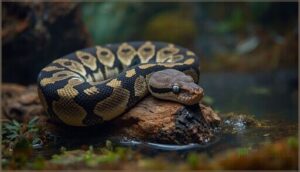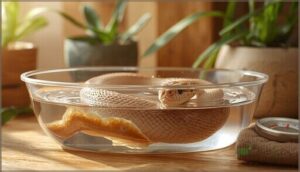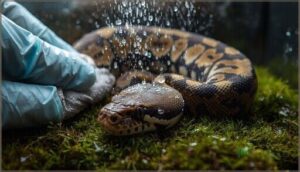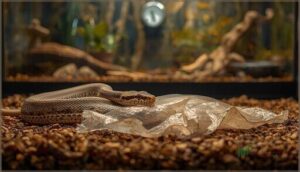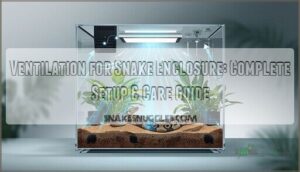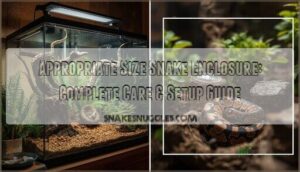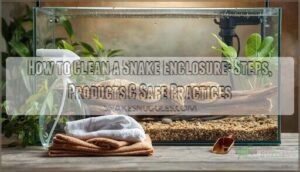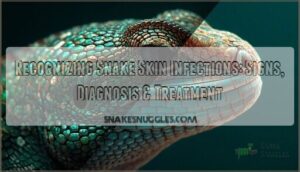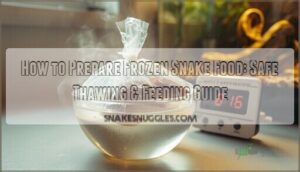This site is supported by our readers. We may earn a commission, at no cost to you, if you purchase through links.
Your snake’s eyes have clouded to a milky blue, its colors dulled to a ghostly matte. Over the next week, your usually calm pet becomes irritable, refusing food and retreating into hiding. This is ecdysis—the natural process of shedding skin—and while it’s perfectly normal, it can go wrong fast.
A stuck shed isn’t just cosmetic. Retained skin around the eyes can cause permanent vision damage, while constricted bands on the tail or body cut off circulation and lead to tissue death. Safe snake shedding assistance means knowing when to intervene and when to step back. The difference between helping and harming often comes down to humidity, timing, and resisting the urge to pull.
With the right environment and a few proven techniques, you can support your snake through every shed without complications.
Table Of Contents
Key Takeaways
- Retained shed around the eyes or body isn’t just cosmetic—it can cause permanent vision damage or cut off circulation, making timely intervention critical when home methods fail.
- Most shedding problems stem from low humidity (aim for 50-70% baseline, higher during shed), inadequate hydration, or missing rough surfaces that help your snake grip and remove old skin naturally.
- Safe assistance means warm water soaks at 78-86°F for 15-20 minutes and humid hides with damp moss—never pull retained skin manually, as this risks corneal trauma and infection.
- Call a reptile vet if you see retained eye caps after multiple soaks, recurring incomplete sheds despite corrected humidity, or signs of infection like swelling or open wounds.
Why Snakes Shed Their Skin
Shedding isn’t just a quirky snake habit—it’s a key process that keeps your pet healthy as it grows. Understanding why snakes shed helps you provide better care and spot potential problems before they become serious.
Let’s break down the essential reasons behind ecdysis and what it means for your snake’s wellbeing.
The Purpose of Shedding (Ecdysis)
Ecdysis has multiple functions beyond simple growth adaptation. This shedding cycle renews the skin surface, removing worn scales and restoring barrier function for water retention. It physically dislodges ectoparasites and debris, supporting parasite removal.
Shedding also aids predator avoidance by reducing scent trails and makes possible sensory restoration—clearing cloudy spectacles returns sharp vision.
A key reason is to accommodate growth. Understanding ecdysis helps you support your snake’s natural health maintenance.
Growth and Skin Health
As your snake grows, its rigid outer layer can’t stretch, so a successful shed is how it “upgrades” the skin to match its larger body. Each complete snake skin shedding cycle renews the epidermal layers and restores barrier function, helping with water conservation and maintaining healthy scales.
Poor nutrition or low humidity can trigger skin infections or incomplete sheds, so you’ll want to support both snake growth and skin health through proper husbandry. Difficulty shedding, also known as dysecdysis in snakes, is often caused by improper environmental conditions.
Shedding Frequency by Age and Species
How often will your snake shed? Juvenile shedding occurs every 3–6 weeks during rapid snake growth, while adult frequency drops to 4–12 times yearly. Ball pythons generally shed every 4–6 weeks; corn snakes often extend to 8–12 weeks as adults.
Species variation and individual patterns matter—faster metabolism means more frequent shedding.
Environmental impact is real: poor humidity or temperature disrupts normal shedding frequency.
Recognizing Signs of Impending Shed
Your snake will show you it’s getting ready to shed if you know what to look for. These signs usually appear several days before the actual shedding process begins, giving you time to adjust the enclosure and prepare.
Let’s walk through the key behavioral and physical changes you can expect during this natural cycle.
Behavioral Changes and Appetite Loss
You’ll likely notice your snake becoming less interested in food as shed approaches—this pre-shed anorexia is completely normal and generally starts 1–2 weeks before the skin comes off. Activity reduction and extra hiding are common preshed signs.
Defensive behavior and handling intolerance also increase during this period, especially when vision is impaired. These behavioral changes reflect stress physiology, not illness, so focus on reducing stress by minimizing handling.
Physical Signs—Cloudy Eyes and Dull Skin
Two hallmark preshed signs are cloudy eyes and skin dullness—both signal the cycle’s early stages. Eye cloudiness, often called “in blue,” appears about 9–14 days before your snake sheds and temporarily reduces visual acuity.
Simultaneously, the body pattern fades to a matte, non-reflective finish. These changes are normal and will clear just before the old skin sloughs off completely.
Typical Shedding Stages (Blue Phase, Clearing Phase)
During ecdysis, your snake transitions through two key preshed signs stages: the blue phase and clearing phase. The blue phase brings spectacle opacity—cloudy eyes lasting several days—and dull skin across the body, reflecting fluid separation beneath the old layer. This skin vulnerability period requires careful husbandry implications like stable humidity.
Eyes then clear 2–5 days before the actual shed, signaling the shedding process nears completion.
Creating a Safe Shedding Environment
Your snake’s enclosure becomes critical when shedding begins. Getting a few key environmental factors right can mean the difference between a smooth, complete shed and frustrating complications that require intervention.
Let’s look at what your snake needs during this vulnerable time.
Maintaining Proper Humidity Levels
Your snake’s humidity levels can make or break a successful shed. Most species thrive between 50-70%, but specific humidity management for snakes varies—ball pythons need 55-60% baseline humidity, while tropical species may require up to 80%.
Use these proven humidity control strategies:
- Humidity measurement tools: Digital hygrometers placed mid-enclosure track levels accurately
- Misting techniques: Fine spray increases humidity to 90-100% temporarily
- Substrate choice and humid hides: Coconut fiber retains moisture; sphagnum moss-filled boxes provide localized humidity
Temperature Stability and Gradient
Just as your snake needs the right humidity, temperature stability and gradient are equally critical for a clean shed. Maintain a basking zone of 88–92°F and a cool end around 75–80°F—this thermal gradient importance allows your snake to thermoregulate naturally.
Use digital thermometers for monitoring temperatures at both ends, and verify heat source placement creates consistent zones. Stable temperatures prevent the shedding delays caused by temperature fluctuations or nighttime temperature drops.
Providing Rough Surfaces and Humid Hides
Your snake can’t peel away old skin without help from its surroundings. Place cork bark, branches, or rough stones throughout the enclosure—surface abrasiveness allows your pet to catch and lift the shed.
Add at least one humid hide filled with damp moss in the warm zone to create microclimate stability. This combination of rough surfaces and a humid hide provides essential shedding assistance without stress.
Enclosure Ventilation and Cleanliness
Stagnant air breeds bacteria and mold—two enemies during your snake’s vulnerable shedding phase. Position ventilation openings around the perimeter to maintain airflow design without losing your carefully controlled humidity balance.
Monitor with a hygrometer and follow cleaning frequency protocols: daily spot-clean waste, weekly disinfect accessories, monthly replace substrate.
These hygiene protocols support disease prevention while keeping bacterial growth in check throughout ecdysis.
Safe Methods for Shedding Assistance
Most snakes shed on their own without any help, but sometimes they need a little support to get through the process safely. If your snake struggles with incomplete shedding, there are gentle, proven methods you can use at home to assist without causing harm.
Let’s walk through the safest approaches to help your snake through a difficult shed.
Minimizing Handling and Reducing Stress
During shedding, your snake’s psychological wellbeing depends on a hands-off approach. Studies show minimizing handling stress directly improves outcomes—handling frequency should drop to zero unless absolutely necessary.
Behavioral responses like hiding and irritability signal stress indicators you can’t ignore. Best practices include environmental mitigation through proper humidity and rough surfaces, creating a stress-free, reducing stress handling experience that lets nature do the work.
Offering Warm Water Soaks
When hands-off methods aren’t enough, warm water soaks offer gentle assistance. Fill a secure container with lukewarm water—around 78–86 °F—just deep enough that your snake rests comfortably without swimming.
Soak for 15–20 minutes, staying present the entire time to prevent drowning. This soak temperature and duration soften stubborn skin, boost hydration, and deliver real soak benefits without stressing your animal.
Using Shedding Aids and Natural Alternatives
Sometimes environmental adjustments and warm water soaks alone don’t cut it. That’s where shedding aids come in—products designed to hydrate stubborn skin and ease the process:
- Commercial sprays are mostly water with emollients like jojoba oil and vitamin E
- Moist hides filled with damp sphagnum moss create humid microenvironments
- Natural oils such as coconut oil condition localized patches cautiously
- Botanical sprays market antibacterial effects but lack reptile-specific safety data
- Husbandry alternatives—proper humidity, clean water, textured surfaces—remain your safest, first-line approach
Use chemical aids sparingly and only after fixing your enclosure setup.
When and How to Remove Retained Skin
Even after optimizing your setup, retained shed—especially on eye caps or tail tips—sometimes needs gentle assistance. Start with repeated warm water soaks and increased humidity to soften stubborn patches over three to four days.
Manual removal risks corneal trauma and infection if done improperly, so work slowly under magnification.
When multiple spectacle layers accumulate, subspectacular fluid appears, or home methods fail, veterinary intervention using sterile hydrodissection becomes essential.
Preventing Common Shedding Problems
Most shedding problems don’t just happen—they’re the result of specific care gaps you can actually fix. Understanding what causes incomplete sheds and how to spot trouble early makes all the difference in keeping your snake healthy.
Let’s look at the most common issues and how to prevent them before they start.
Causes of Incomplete Shedding
Low humidity tops the list when addressing incomplete shedding health issues—think of it as trying to peel a sticker off dry paper. Dehydration effects compound the problem by reducing skin elasticity.
Low humidity is the leading cause of incomplete sheds, making skin as difficult to remove as a sticker on dry paper
Nutritional deficiencies weaken the epidermis, making dysecdysis more likely. Parasite infestations irritate scales, creating patchy retained shed.
Stress factors, from poor handling to inadequate hiding spots, disrupt your snake’s natural shedding cycle and trigger common shedding problems.
Importance of Hydration and Nutrition
Your snake’s hydration strategies directly determine whether it sheds cleanly or struggles with stuck skin. Fresh water availability matters—snakes refuse stagnant bowls, reducing water intake during critical pre-shed periods.
Vitamin deficiencies from poor prey quality compromise skin elasticity, while inadequate water access triggers dysecdysis in snakes losing over 15% body mass. Nutritional support through whole prey prevents the deficiencies that cause incomplete sheds.
Identifying and Addressing Retained Shed
When patches of old skin cling to your snake’s body—especially around the head, eyes, or tail tip—you’re seeing dysecdysis, a sign that something in the environment or diet needs fixing. Retained eye caps appear as cloudy films that don’t clear after shedding.
Start with humidity correction and warm soaks under supervision; if multiple layers accumulate or your snake rubs its face repeatedly, veterinary intervention prevents vision loss and infection.
Monitoring for Skin Infections and Health Issues
If you notice raised crusts, ulcers, or discolored patches on your snake’s scales—especially between sheds—you’re looking at potential skin infections like scale rot that won’t resolve on their own. Behavioral changes such as prolonged lethargy, appetite loss beyond typical shed cycles, or repeated shed irregularities demand veterinary intervention.
Early lesion identification and consulting a reptile veterinarian protect your snake from preventable complications.
Post-Shedding Care and Monitoring
After your snake completes its shed, your job isn’t quite finished. You’ll need to inspect the enclosure, check your snake carefully, and watch for any signs that something didn’t go as planned.
Here’s what you should do in the hours and days following a successful shed.
Cleaning The Enclosure and Removing Shed Skin
After your snake finishes shedding, removing excess skin and cleaning the enclosure right away helps prevent bacterial growth and mold risk. Spot-clean daily to remove shed skin, feces, and spills—those simple steps reduce pathogen risks greatly.
For deep enclosure cleaning every few months, use warm water with mild detergent, then apply a reptile-safe disinfectant for about 10 minutes. Rinse thoroughly before returning your snake.
Checking for Retained Eye Caps or Skin
After a complete shed, carefully examine your snake’s eyes for retained eye caps—the most common eye abnormality in captive snakes. Look for dull, wrinkled spectacles or visible edges around the eye; check the shed skin for two clear eye scales.
If you spot asymmetry, cloudiness, or face-rubbing behavior, seek veterinary care promptly. Home removal risks corneal scarring and infection.
Ensuring Hydration and Stress Reduction
Once you’ve confirmed your snake’s eyes and skin are clear, focus on hydration and stress reduction. Offer fresh water in a clean bowl large enough for soaking—many snakes drink heavily after shedding. Keep humidity stable at 50–70% and resist rearranging the enclosure.
Provide hiding spots and minimize handling for a few days. A stress-free environment aids full recovery and sets the stage for the next healthy shed.
When to Consult a Reptile Veterinarian
If home care fails or problems recur across multiple sheds, it’s time to call a reptile vet. Watch for these red flags:
- Persistent dysecdysis lasting weeks despite corrected humidity
- Retained spectacles that won’t budge after gentle soaking
- Systemic illness signs—lethargy, wheezing, or prolonged appetite loss
- Skin infections showing swelling, blackening, or open wounds
Forced removal risks serious damage. When nonresponsive care continues, veterinary expertise protects your snake’s health.
Frequently Asked Questions (FAQs)
Can snakes shed during brumation or hibernation?
While you might assume snake shedding stops entirely during dormancy, snakes can shed during brumation, though the process slows considerably—taking up to six weeks—due to drastically reduced metabolic rates and cooler temperatures.
Do different snake morphs shed differently?
Snake morphs generally shed through the same ecdysis process, but visual differences appear during pre-shed phases.
Albino morphs show less obvious blue-eye clouding, while structural traits like spider morph wobble may complicate self-assisted shedding behaviors.
Should I feed my snake immediately after shedding?
Your snake’s appetite surges after the long wait. Most snakes readily accept food within 24 hours post-shed, though waiting until their regular feeding day prevents overfeeding and fosters healthy digestion upregulation.
How does dehydration affect the shedding timeline?
Dehydration symptoms prolong shed duration by 3-7 days and cause retained shed dysecdysis. Low humidity levels extract moisture through osmotic stress, preventing proper skin separation.
Rehydration methods and correcting humidity effects restore normal shedding timelines within 24 hours.
Can multiple snakes share a humid hide?
You shouldn’t let multiple snakes share a humid hide. Disease transmission, stress from crowding, and competition increase when they’re packed together.
Provide each snake its own humid retreat to protect snake health and maintain proper humidity levels for shedding.
Conclusion
What separates a smooth shed from a veterinary emergency? Usually, it’s humidity and patience. Safe snake shedding assistance isn’t about intervening at the first sign of trouble—it’s about creating conditions where your snake can do what comes naturally.
Monitor the environment, watch for genuine complications like retained eye caps or constricted bands, and resist the urge to pull. When you get it right, your snake emerges healthy, vibrant, and ready to eat again.
- https://companion-animals.extension.org/shedding-management-for-companion-reptiles/
- https://wpvet.com/exotic-pets-care-guides/reptile-shedding-ecdysis/
- https://www.pets4homes.co.uk/pet-advice/retained-eye-caps-in-snakes-explained.html
- https://avianexoticvetcare.com/reptiles-amphibians/shedding-reptiles
- https://www.petmd.com/reptile/conditions/skin/dysecdysis-reptiles


